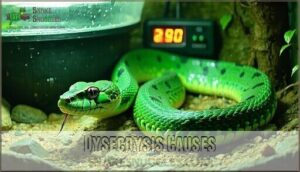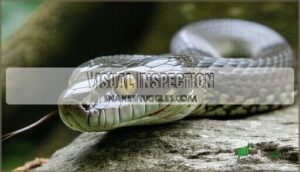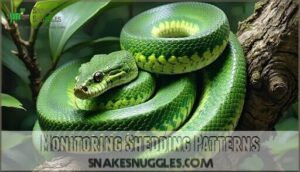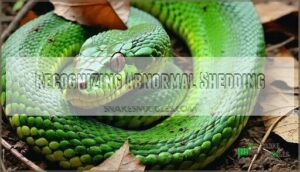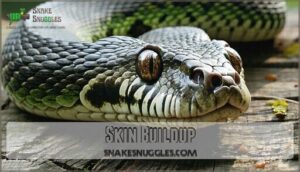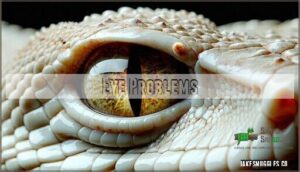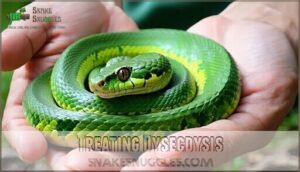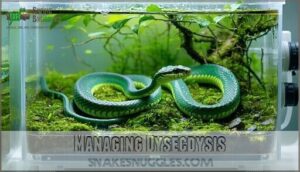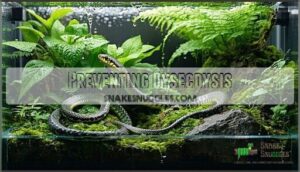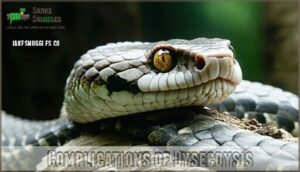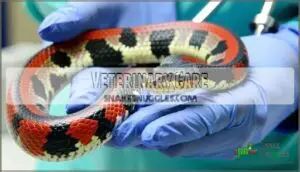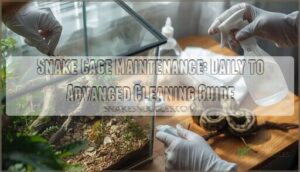This site is supported by our readers. We may earn a commission, at no cost to you, if you purchase through links.
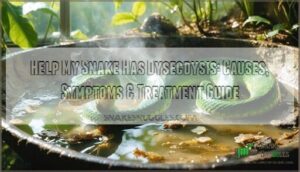
This condition happens when your snake can’t shed its skin properly, leaving patches of old skin stuck like a bad sweater.
The main culprits are low humidity, poor nutrition, or stress.
You’ll spot dull skin, retained eye caps, or patchy shedding that won’t come off.
Start by boosting humidity to 60-80% and offering warm water soaks.
Most cases respond well to environmental fixes, but severe situations might need veterinary care.
The good news? With the right approach, your snake will be back to smooth, successful sheds in no time.
Table Of Contents
- Key Takeaways
- What is Dysecdysis
- Dysecdysis Causes
- Identifying Dysecdysis
- Dysecdysis Symptoms
- Treating Dysecdysis
- Managing Dysecdysis
- Preventing Dysecdysis
- Complications of Dysecdysis
- Veterinary Care
- Recovering From Dysecdysis
- Frequently Asked Questions (FAQs)
- How do you treat Dysecdysis in snakes?
- What is Dysecdysis in snakes?
- How do you know if a snake has Dysecdysis?
- How do you handle a snake during ecdysis?
- What does Dysecdysis mean in reptiles?
- How do you get rid of Dysecdysis?
- What causes dysecdysis in snakes?
- What to do if your snake is having trouble shedding?
- What causes snakes to have diarrhea?
- How to get rid of snake parasites?
- Conclusion
Key Takeaways
- Boost humidity immediately – Raise levels to 60-80% and provide warm water soaks to soften stuck skin patches before they cause circulation problems
- Watch for warning signs – Look for dull, patchy skin, retained eye caps, and behavioral changes like excessive rubbing or appetite loss
- Create proper shedding conditions – Maintain consistent temperatures, provide rough surfaces for rubbing, and ensure your snake’s getting a balanced diet with adequate vitamin A
- Don’t wait on severe symptoms – If you see open wounds, eye infections, or signs your snake’s getting sicker after a few days of home treatment, get veterinary care immediately
What is Dysecdysis
If you’ve noticed your snake struggling with shedding, you’re dealing with dysecdysis – a condition where old skin doesn’t come off properly during the natural shedding process.
This abnormal shedding creates buildup on your snake’s body, particularly around the eyes, tail tip, and limbs, signaling that something’s wrong with their environment or health.
Definition and Explanation
When your snake’s shedding cycle goes wrong, you’re dealing with dysecdysis – abnormal shedding that leaves retained skin stuck to your reptile.
This snake shedding problem occurs when the natural reptile ecdysis process fails, creating stuck shed patches instead of complete skin removal.
Unlike healthy snake shedding, dysecdysis results in retained skin buildup that can threaten your pet’s health and comfort.
Causes of Dysecdysis
Understanding what triggers dysecdysis helps you protect your snake from this frustrating condition.
Environmental stress from incorrect temperature or low humidity creates the perfect storm for shedding problems.
Poor hygiene breeds bacteria that damage skin, while rough handling causes skin trauma.
Parasite infestation weakens your snake’s immune system, and nutritional deficiencies prevent healthy skin development, making normal shedding nearly impossible.
Providing proper husbandry helps avoid common causes of this condition, which can lead to shedding problems and requires careful management to prevent skin trauma.
Symptoms and Signs of Dysecdysis
Recognizing dysecdysis symptoms early helps you address stuck shed before complications develop.
Your snake’s skin will look dull and cloudy, often with patches of retained shed clinging to the body.
You’ll notice these telltale signs:
- Retained eyecaps – cloudy, opaque eye caps that didn’t shed properly
- Skin constriction around toes, tail tip, or body creating tight bands
- Dull skin with flaky patches instead of vibrant, glossy scales
- Appetite loss and reduced activity levels during shedding difficulties
Dysecdysis Causes
Understanding what’s causing your snake’s dysecdysis is the first step to helping them shed properly again.
Identifying dysecdysis early means the difference between simple home care and serious veterinary intervention.
You’ll find that most shedding problems stem from three main areas: environmental conditions, underlying health issues, and nutritional gaps in their diet, which can be summarized as issues related to diet.
Environmental Factors
Poor environmental conditions create the perfect storm for snake stuck shed problems.
Low humidity snake environments cause skin to dry out, making normal shedding nearly impossible.
Temperature gradients must stay consistent—fluctuations stress your snake’s system.
Inadequate enclosure size restricts movement needed for rubbing off old skin.
Wrong substrate choice eliminates natural abrasive surfaces.
Improper lighting needs disrupt shedding cycles, while environmental stressors compound these humidity levels issues, creating a perfect storm for stuck shed problems.
Health Issues
Beyond environmental factors, underlying diseases frequently trigger dysecdysis in your snake.
Parasite infestation, especially mites, damages skin integrity and disrupts normal shedding cycles. Bacterial infections create septicemia risk, while vitamin deficiency weakens cellular regeneration.
Chronic conditions often present with recurring snake stuck shed episodes. Severe cases may require amputation necessity when circulation fails, making early detection essential for preventing serious reptile health problems.
Snakes typically shed due to growth and age.
Nutritional Deficiencies
Your snake’s nutritional deficiencies can trigger dysecdysis just like health problems.
Vitamin A deficiency causes dry skin and retained sheds, while calcium imbalance affects skin elasticity.
Poor prey nutritional value from monotonous diets lacks essential nutrients. A balanced diet with proper supplementation risks management prevents these issues.
Diet diversity guarantees adequate fatty acid intake for healthy shedding cycles. Making certain a proper diet includes attention to the calcium phosphorus ratio.
Identifying Dysecdysis
You can spot dysecdysis by looking for telltale signs like dull, patchy skin and pieces of old shed stuck to your snake’s body.
The key is knowing what normal shedding looks like versus when things go wrong.
Visual Inspection
Looking at your snake’s skin appearance during visual inspection reveals key signs of dysecdysis.
Check for retained eyecaps that look cloudy or opaque, dull scale condition, and patches of old skin stuck to body regions like tail tips and toes.
Your snake’s behavioral clues, including excessive rubbing, signal a snake shedding problem requiring immediate attention to prevent complications from this dysecdysis condition.
Monitoring Shedding Patterns
Tracking your snake’s shedding cycle helps catch dysecdysis early.
Healthy snakes shed every 4-8 weeks, with juveniles shedding more frequently than adults.
Keep a simple log noting shedding dates and completeness.
Watch for pattern irregularities like delayed sheds or incomplete skin removal.
A consistent shedding environment with proper humidity makes monitoring easier and more accurate, helping you maintain a healthy snake through its shedding cycle, including the process of shedding.
Recognizing Abnormal Shedding
Understanding your snake’s normal patterns helps you spot trouble.
Healthy snakes shed every 4-8 weeks, but dysecdysis breaks this rhythm.
Watch for these warning signs that signal snake shedding issues:
- Incomplete snake shed – Patches of old skin stick around toes, tail, or belly areas
- Retained shed snake spectacles – Cloudy eye caps don’t come off, looking like dirty contact lenses
- Skin appearance changes – Dull, wrinkled texture instead of smooth, vibrant scales
- Behavioral indicators – Your snake rubs excessively against objects or shows appetite loss
Complete sheds should happen in one piece.
When shedding frequency drops or skin stays patchy, you’re seeing dysecdysis treatment territory.
Dysecdysis Symptoms
You’ll notice several key symptoms when your snake struggles with dysecdysis, including retained skin patches, cloudy eyes, and changes in behavior.
These warning signs help you identify shedding problems early and take action before complications develop, which is crucial for the snake’s health and well-being, especially when dealing with complications.
Skin Buildup
When skin buildup occurs around your snake’s toes, tail, or body creases, you’re witnessing dysecdysis in action.
This retained shed creates thick patches where old skin accumulates instead of sloughing off naturally.
Scale accumulation typically appears in high-friction areas like armpits and feet, where shedding frequency should match your snake’s growth cycle.
Skin thickness increases as layers compress together, potentially restricting circulation and causing permanent scar tissue if left untreated, which can be a result of untreated skin buildup.
Eye Problems
Your snake’s eyes tell a concerning story when dysecdysis strikes.
Retained eyecaps create cloudy eyes that resemble dirty windows, blocking your pet’s vision.
These snake eye caps won’t shed naturally, trapping moisture underneath and creating perfect conditions for eye infections.
Without prompt treatment, corneal damage develops rapidly, potentially causing permanent vision impairment or blindness in severe cases.
Behavioral Changes
Several behavioral changes signal your snake’s shedding frustration.
You’ll notice increased hiding behavior as your pet seeks comfort from dysecdysis stress.
Lethargy signs become obvious when your snake moves less and seems unusually tired.
Appetite changes follow, with most snakes showing refusal to eat during difficult sheds.
Excessive rubbing against objects indicates irritation, while increased irritability makes handling challenging during this uncomfortable period.
Increased aggression can also be a sign of stress, so monitor for changes in temperament that could indicate environmental or handling issues, related to environmental or handling issues, which may cause stress.
Treating Dysecdysis
If you’ve spotted retained skin on your snake, don’t panic—dysecdysis is treatable with the right approach. The key is acting quickly to prevent complications like infections or circulation problems.
Boosting Humidity
Now that you’ve spotted the warning signs, you’ll need to raise humidity levels quickly.
Create a humid hide using damp sphagnum moss in a container with an entrance hole. Sphagnum moss products are widely available for this purpose.
Check your hydrometer regularly and maintain humidity between 70-80% for most snake species.
Adjust misting frequency based on your enclosure size and substrate choice to prevent dysecdysis from worsening.
Warm Water Soaks
Once humidity levels rise, warm water soaks become your next tool for tackling stubborn retained skin.
This gentle method softens dried skin patches, making removal safer and more effective.
Here’s how to properly soak your snake:
- Water Temperature: Use lukewarm water (80-85°F) – hot enough to soften skin but cool enough to avoid burns
- Soak Duration: Allow 10-15 minutes for the water to penetrate and loosen stuck skin
- Gentle Scrubbing: Use a soft cloth or your fingers to carefully rub loosened skin away
- Drying Methods: Pat dry with a clean towel before returning your snake to its enclosure.
A proper snake soaking tub can greatly assist with this process.
Antibiotic Treatment
While soaks soften retained skin, bacterial infections require targeted antibiotic treatment.
Secondary bacterial infections from dysecdysis need prompt medical attention to prevent septicemia and sepsis.
| Antibiotic Types | Treatment Duration |
|---|---|
| Enrofloxacin | 7-10 days |
| Amikacin | 5-7 days |
| Ceftazidime | 10-14 days |
Resistance concerns make dosage calculation critical—your vet will determine proper amounts based on your snake’s weight.
Probiotics needed during treatment help restore healthy gut bacteria while fighting skin infections.
Managing Dysecdysis
Once you’ve treated your snake’s dysecdysis, you’ll need to manage the condition to prevent complications and guarantee complete recovery.
This involves creating humidity chambers, providing proper nutrition, and scheduling regular vet visits to monitor your snake’s progress.
Humidity Chambers
Creating a humidity chamber for your snake’s dysecdysis requires simple materials like a plastic container with air holes and damp moss or towels.
Monitor humidity levels between 70-80% using a hygrometer, adjusting moisture as needed. Digital hygrometers provide essential humidity readings.
Different species need varying humidity levels, so research your snake’s specific requirements.
Clean chamber materials regularly to prevent bacterial growth and replace substrate when soiled.
Nutritional Support
Your snake’s recovery depends on addressing nutritional deficiencies that contribute to poor shedding.
A well-fed snake with a balanced diet rarely experiences dysecdysis.
Provide vitamin A supplementation and guarantee adequate hydration through proper prey selection.
Essential fatty acids support skin health, while targeted supplements can correct nutritional imbalances affecting the shedding process, ensuring proper hydration.
Regular Veterinary Check-ups
You’ll need ongoing veterinary care to confirm your snake’s dysecdysis resolves completely and doesn’t return.
Expert advice helps identify underlying causes that basic husbandry changes might miss.
- Early detection through regular health monitoring prevents minor shedding issues from becoming serious complications
- Preventative care includes treatment planning for recurring dysecdysis and addressing systemic health problems
- Professional assessment by a reptile vet guarantees proper diagnosis of snake skin shedding problems and appropriate intervention
Preventing Dysecdysis
You can prevent dysecdysis by maintaining proper humidity levels, providing adequate rubbing surfaces, and ensuring your snake receives a balanced diet.
These three key factors address the root causes of shedding problems and keep your reptile’s skin healthy throughout its natural shedding cycle, which involves complete concepts of care.
Maintaining Humidity
Humidity levels between 50-60% prevent dysecdysis in most snake species.
Your enclosure size affects how quickly humidity drops, so larger tanks need more attention. Misting systems work well, but check substrate choice since some materials hold moisture better.
Place your hydrometer away from water bowls for accurate readings. A humid hide gives your snake a retreat when shedding begins, and using a misting system can help maintain the right humidity levels.
Providing Rubbing Surfaces
Beyond humidity control, your snake needs proper rubbing surfaces for healthy shedding behavior.
Rough textures help snakes naturally remove old skin during their shedding cycle.
Here are key considerations for snake enclosure surfaces:
- Surface Texture – Include rough bark, cork rounds, or textured rocks that allow natural rubbing without causing injury
- Enclosure Placement – Position surfaces at various heights so your snake can access them easily during snake shedding
- Material Safety – Choose non-toxic, easily cleaned materials that won’t harbor bacteria or damage delicate skin
- Natural Options – Driftwood and natural stone provide authentic textures that encourage proper shedding behavior.
Many owners find that textured reptile products assist with shedding.
Balanced Diet
Nutrition serves as your snake’s foundation for healthy shedding cycles.
You’ll need a diet rich in Vitamin A, which supports proper skin cell development and prevents dysecdysis.
Calcium intake guarantees strong scales, while Essential Fatty Acids maintain skin flexibility.
Hydration importance can’t be overstated—well-hydrated snakes shed easier, and it’s crucial for superior snake care.
However, supplementation risks exist with over-dosing vitamins, so stick to balanced reptile nutrition through whole prey items.
Complications of Dysecdysis
If you don’t address dysecdysis quickly, your snake can develop serious complications that threaten its health and quality of life.
Infections, skin lesions, and permanent eyesight damage are the most common problems that occur when retained skin isn’t properly removed, which can lead to serious health issues.
Infections
When secondary infections strike, they turn your snake’s simple shedding problem into a serious health crisis.
Bacterial infections and fungal infections commonly develop in retained skin areas, creating perfect breeding grounds for harmful microorganisms.
These skin infections can rapidly progress to septicemia, threatening your snake’s life.
Parasitic infections also exploit weakened skin barriers, while abscess formation may occur around infected tissue.
Skin Lesions
Skin lesions develop when retained shed creates wounds and tears on your snake’s body.
These open areas become breeding grounds for bacterial infections and fungal infections, increasing infection risk substantially.
Lesion severity depends on how long the dysecdysis persists – minor scrapes can quickly escalate into deep wounds.
Treatment options include topical antibiotics and antifungal medications, but scarring potential remains high.
Preventative measures focus on maintaining proper humidity and substrate conditions to avoid skin damage entirely, which can help prevent fungal infections.
Eyesight Damage
Retained eye caps can trap your snake in a cloudy nightmare, blocking vision and causing serious eye damage.
Spectacle retention leads to vision impairment, corneal ulceration, and secondary infections that threaten your pet’s sight.
Multiple sheds with stuck eye caps create thick layers over the eyes, narrowing your snake’s visual field and potentially causing permanent blindness without proper intervention, which can lead to a condition of cloudy nightmare.
Veterinary Care
While most dysecdysis cases respond well to home treatment, you’ll need professional veterinary care if your snake shows severe symptoms like open wounds, eye infections, or signs of systemic illness.
Don’t wait if the condition worsens after a few days of treatment—early intervention prevents serious complications and guarantees your pet’s recovery.
Severe Symptoms
When complications worsen, you’ll notice severe symptoms that demand immediate veterinary attention.
Watch for signs of sepsis like lethargy and loss of appetite, plus systemic infections spreading beyond the skin.
Eyesight damage from retained eye caps can lead to permanent blindness if untreated.
Circulation cutoff creates necrotic tissue, especially around toes and tail tips, requiring amputation risks assessment by your vet.
Regular check-ups can help with early warning signs to prevent severe complications, ensuring timely veterinary attention.
Systemic Diseases
Septicemia effects your snake’s entire body, creating widespread infection that compromises skin health and normal shedding cycles.
Paramyxovirus impact includes neurological symptoms and weakened immunity, while inclusion body disease affects boas and pythons similarly.
Thyroid dysfunction disrupts hormone balance, and organ failure from systemic diseases like sepsis creates dangerous complications requiring immediate veterinary intervention.
Failure to Improve
When treatment resistance becomes apparent, your snake’s dysecdysis might signal underlying conditions requiring advanced diagnostics.
Refractory dysecdysis that doesn’t respond to standard humidity adjustments and warm soaks demands immediate veterinary intervention.
Your vet will investigate systemic diseases, nutritional deficiencies, or parasitic infections causing treatment failure, which can lead to prognosis concerns when complications persist despite proper care.
Recovering From Dysecdysis
Once you’ve successfully treated your snake’s dysecdysis, proper recovery care guarantees lasting improvement and prevents future shedding problems.
You’ll need to monitor your snake’s progress closely while maintaining ideal environmental conditions to support healthy skin regeneration.
Post-Treatment Care
After veterinary care, you’ll need to maintain proper wound care and follow your supplementation schedule closely.
Monitor your snake’s shedding patterns while making necessary habitat adjustments like humidity levels.
Keep up with antibiotics as prescribed and maintain clean home care routines.
Schedule follow-up exams to track healing progress and prevent complications.
Monitoring Progress
Keep tabs on your snake’s recovery after dysecdysis treatment by watching for positive changes.
Monitor shedding frequency, skin elasticity, and appetite changes closely. Proper humidity and veterinary care support healing, while behavior observation helps track progress.
- Shedding Frequency: Normal cycles return within 4-6 weeks post-treatment
- Skin Elasticity: Healthy skin appears supple and flexible, not tight or wrinkled
- Appetite Changes: Gradual return to regular feeding patterns indicates recovery
- Behavior Observation: Active movement and normal basking behavior signal improvement
- Hydration Levels: Proper water intake supports skin health and prevents future episodes
Preventing Future Episodes
Once you’ve successfully treated your snake’s dysecdysis, focus on preventative measures to stop future episodes.
Maintain ideal humidity levels specific to your species requirements and provide proper enclosure enrichment with rough surfaces for natural shedding aids.
Feed a balanced proper diet, schedule regular checkups, and monitor temperature regulation closely.
Good snake husbandry prevents most shedding problems from returning.
Frequently Asked Questions (FAQs)
How do you treat Dysecdysis in snakes?
When your snake’s struggling with stubborn shed, warm water soaks work like magic.
Gently increase humidity to 80-90%, provide rough surfaces for rubbing, and offer lukewarm baths to soften retained skin naturally.
What is Dysecdysis in snakes?
Dysecdysis is abnormal or incomplete shedding in snakes where pieces of old skin remain stuck to their body, especially around eyes, tail tips, and toes, indicating environmental problems.
How do you know if a snake has Dysecdysis?
Like a telegram from yesteryear, you’ll spot retained skin patches on your snake’s body, cloudy eyes, dull colors, and tight skin bands around toes or tail that didn’t shed properly.
How do you handle a snake during ecdysis?
Handle your snake minimally during ecdysis.
Avoid unnecessary touching since their skin becomes sensitive and vulnerable.
If you must handle them, use gentle, slow movements and support their body properly to prevent skin damage or stress during this delicate shedding period.
What does Dysecdysis mean in reptiles?
Poor shedding in reptiles occurs when dead skin doesn’t come off properly.
You’ll see stuck skin pieces, especially around eyes, toes, and tail.
It’s usually caused by low humidity or poor habitat conditions.
How do you get rid of Dysecdysis?
Just like a snake trapped in yesterday’s skin, you’ll need to create a warm, humid environment for healing.
Increase humidity to 70-80%, provide warm water soaks twice daily, and gently remove loose skin with clean hands.
Consult your vet immediately.
What causes dysecdysis in snakes?
Environmental factors like low humidity, poor temperature control, and lack of rough surfaces cause most dysecdysis cases.
Nutritional deficiencies, parasites, infections, and improper handling also contribute to your snake’s shedding problems, which can be considered as environmental factors and nutritional deficiencies.
What to do if your snake is having trouble shedding?
Like a snake stuck in yesterday’s skin, your pet needs gentle help escaping its shedding struggle.
Increase humidity, provide warm soaks, and add rough surfaces for rubbing.
Remove loose skin carefully, but avoid eye caps—let those fall naturally.
Ensure your pet’s comfort and safety during this process by being gentle.
What causes snakes to have diarrhea?
Your snake gets diarrhea from poor diet, parasites, stress, bacterial infections, sudden temperature changes, or contaminated water. Check feeding schedule, enclosure conditions, and consult a reptile veterinarian for proper diagnosis.
How to get rid of snake parasites?
A stitch in time saves nine—treat snake parasites quickly to prevent serious health issues.
Consult a reptile veterinarian for proper diagnosis and medication like ivermectin or permethrin.
Clean the enclosure thoroughly and maintain proper humidity levels, which is crucial for preventing the spread of parasites, and remember that a stitch in time saves nine.
Conclusion
Imagine this scenario: you notice your ball python struggling and think, “Help, my snake has dysecdysis!” Don’t panic.
By bumping up the humidity, giving warm soaks, and tuning in to your snake’s environment, you’ll likely solve the problem at home.
Keep an eye out for patches of stuck skin or dull eyes—those are your signals. If things don’t improve, a vet visit means your snake gets proper care.
Consistent monitoring means your scaly friend stays healthy and sheds smoothly.
- https://www.merckvetmanual.com/exotic-and-laboratory-animals/reptiles/parasitic-diseases-of-reptiles
- https://www.ncbi.nlm.nih.gov/pmc/articles/PMC7110871/
- https://members.arav.org/search/custom.asp?id=3661
- https://www.vetlexicon.com/exotis/reptiles/dermatology/articles/ecdysis-dysecdysis/
- https://myavho.com/storage/app/media/Dysecdysis_Care_Card.pdf

